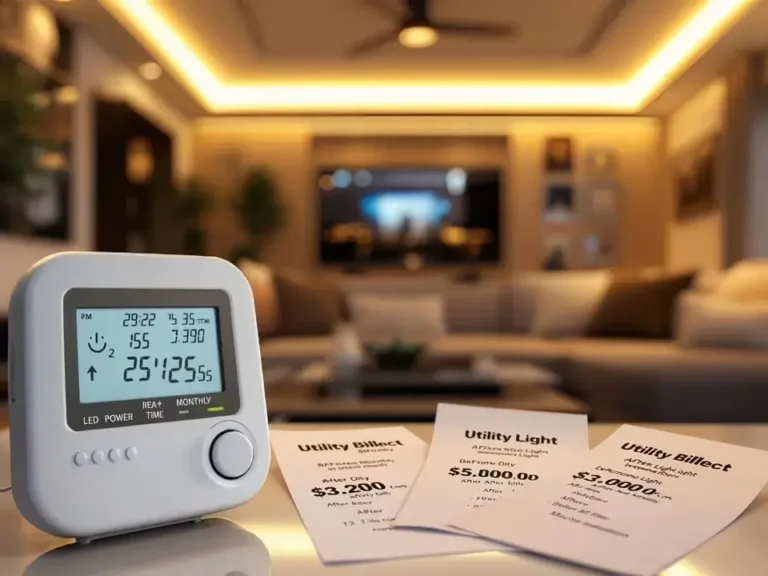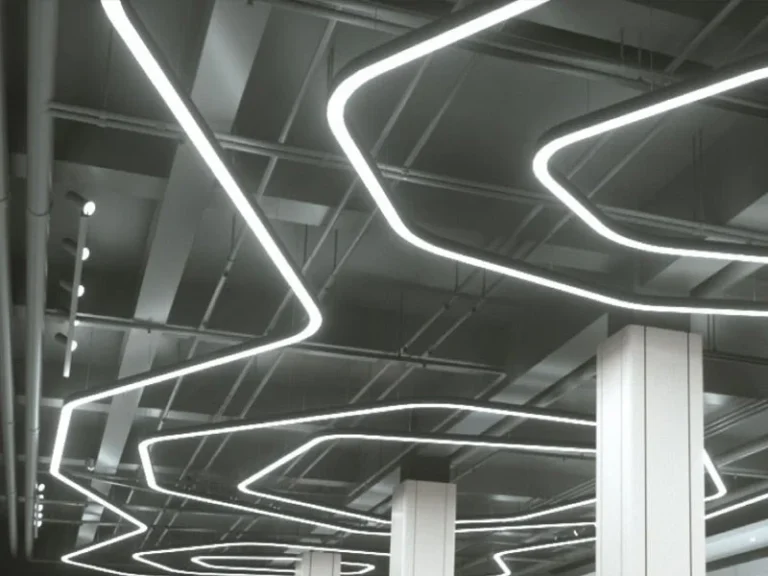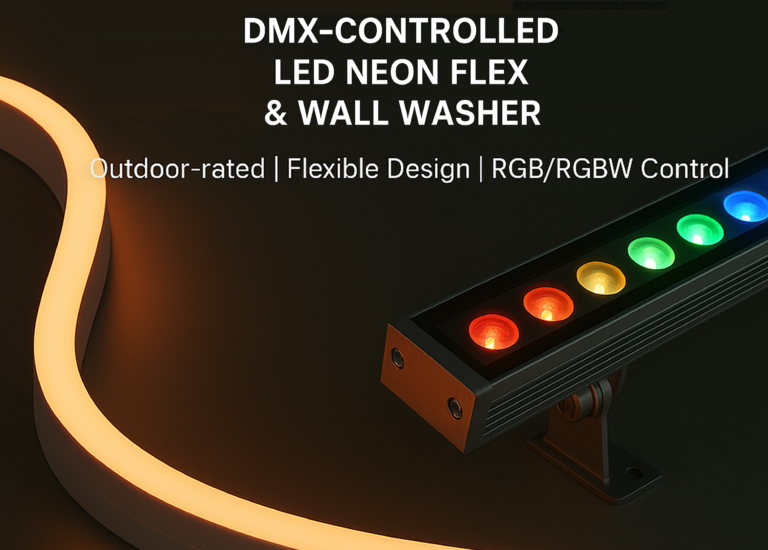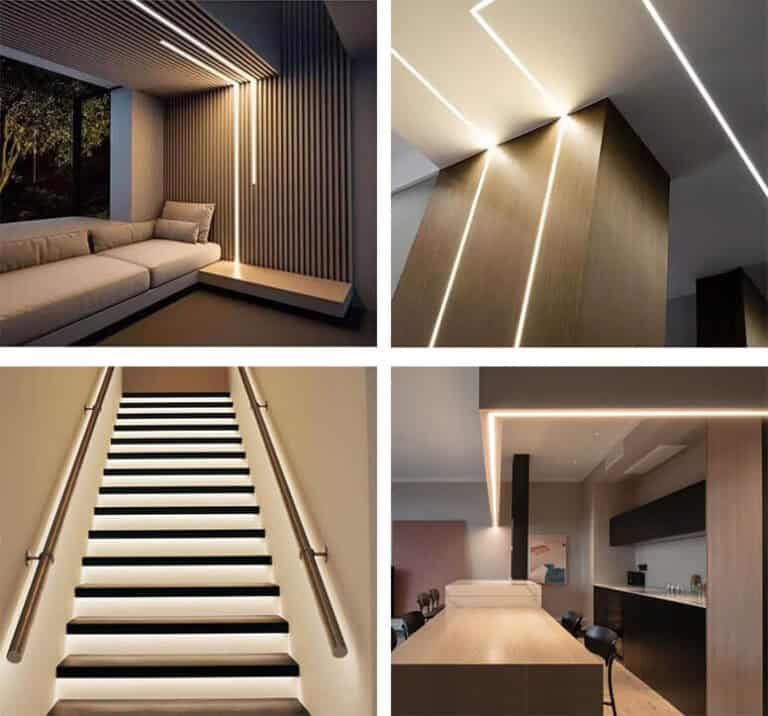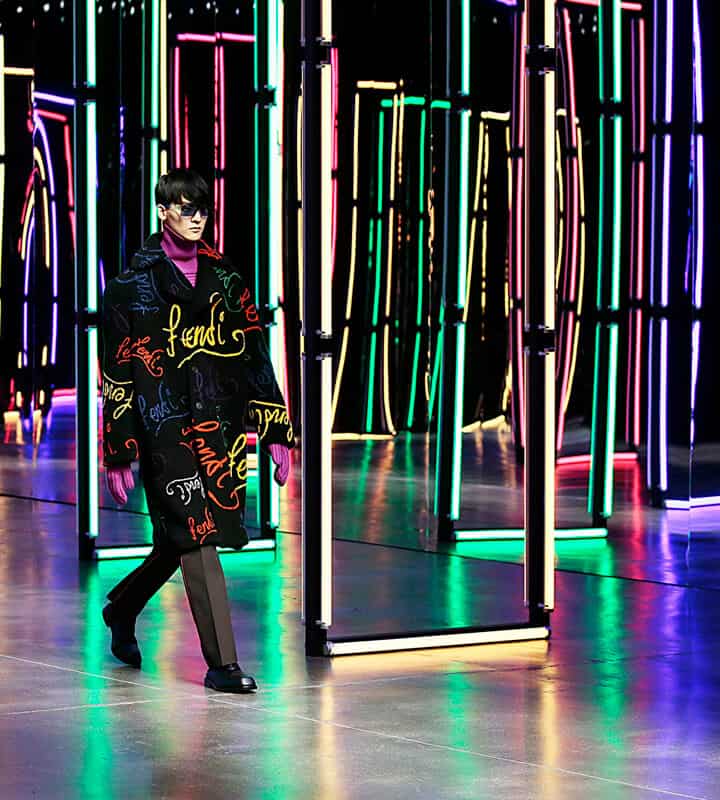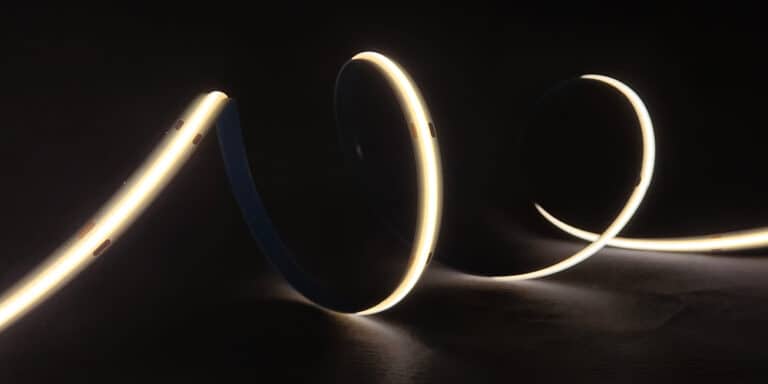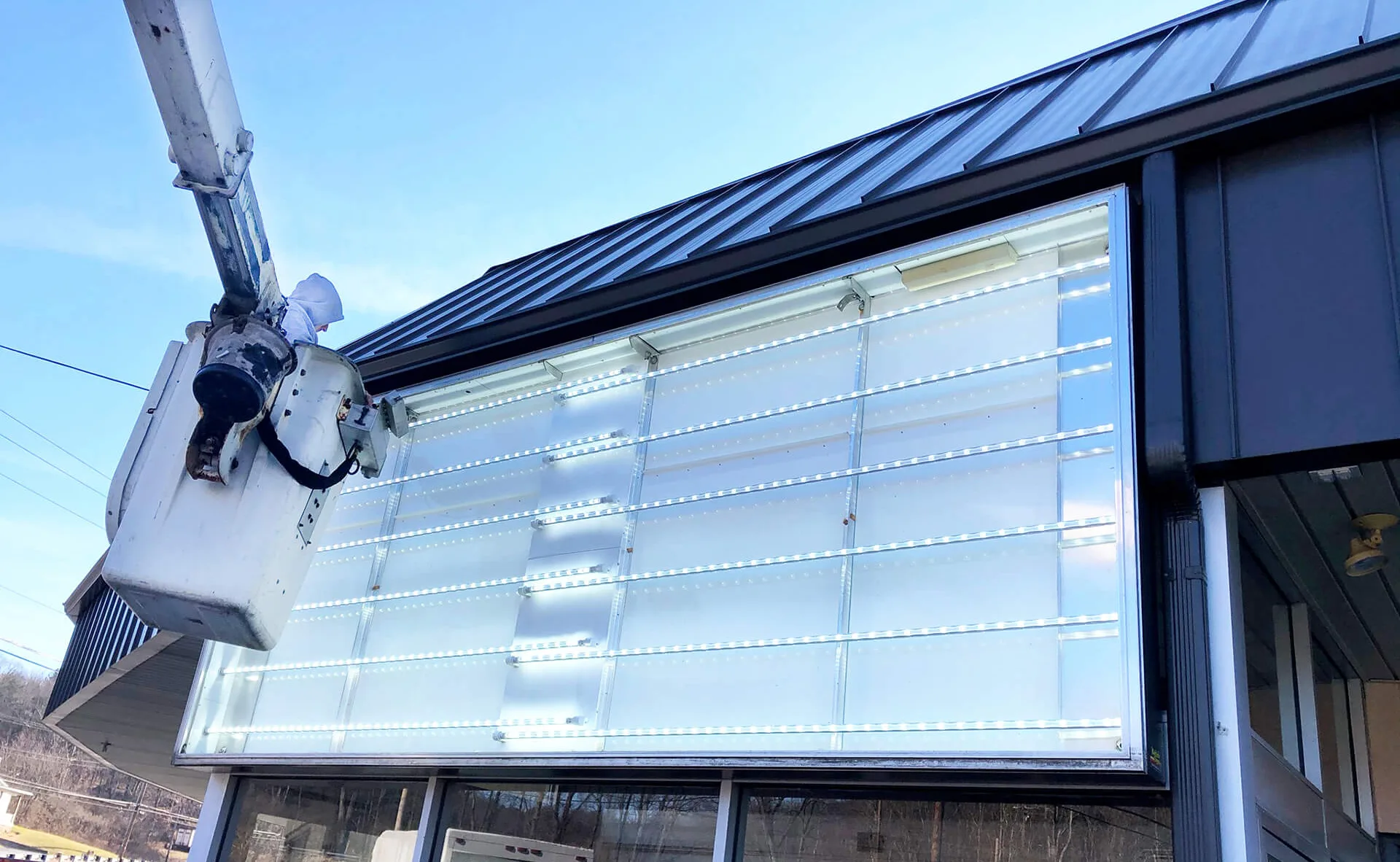
Hai mươi năm trước, tất cả các biển báo tủ và biển báo tháp đều phát quang, để lại nhiều biển báo cũ hơn không có đèn LED, trong khi các biển báo được chiếu sáng mới hơn như bảng hiệu tủ, biển báo tháp và biển báo tùy chỉnh sử dụng đèn LED. Do đó, điều bắt buộc là phải trang bị thêm các biển báo cũ hơn, chẳng hạn như biển báo tháp, biển báo tủ và tượng đài, từ huỳnh quang đến đèn LED. Những dấu hiệu lớn này đã có từ 20–40 năm, và chúng đòi hỏi nhiều loại dịch vụ, đó là một thách thức.
Theo Bộ Năng lượng Hoa Kỳ (DOE), ánh sáng huỳnh quang tuyến tính chiếm hơn 3/4 năng lượng được sử dụng bởi các bảng hiệu thương mại và các tòa nhà thương mại. Vì vậy, bạn có thể tưởng tượng bạn có thể tiết kiệm được bao nhiêu năng lượng bằng cách chuyển sang các tùy chọn ánh sáng tiết kiệm năng lượng như đèn LED.
Đèn LED là nguồn chiếu sáng cực kỳ tiết kiệm năng lượng. Theo Bộ Năng lượng Hoa Kỳ, đèn LED (đặc biệt là năng lượng- Đèn LED được chứng nhận sao) sử dụng ít nhất 75% năng lượng so với bóng đèn sợi đốt và kéo dài hơn tới 25 lần. Đến năm 2027, việc tiếp tục sử dụng đèn LED có thể tiết kiệm được gần 348 TWh điện. Vì vậy, bạn nên xem xét trang bị thêm đèn LED để tăng giá trị thị trường và tính kinh tế của bảng hiệu tủ của bạn và cải thiện hiệu quả năng lượng.
Trang bị thêm LED là gì?
Từ “retrofit” có nghĩa là “chuyển đổi” và trang bị thêm LED có nghĩa là nâng cấp ánh sáng hiện tại của bạn lên các thiết bị LED chi phí thấp, tiết kiệm năng lượng. Vì vậy, trong một trang bị thêm đèn LED, bạn đang chuyển đổi công nghệ chiếu sáng lỗi thời (chẳng hạn như CFL, đèn huỳnh quang và HID) sang công nghệ chiếu sáng tiên tiến (chẳng hạn như đèn LED).
Mặc dù trang bị thêm biển báo là quá trình nâng cấp hoặc trang bị thêm một biển báo hiện có để cải thiện hiệu suất, hiệu quả năng lượng hoặc chức năng của nó, việc trang bị thêm biển báo LED liên quan đến việc thay thế các thiết bị chiếu sáng truyền thống bằng đèn LED. Điều này thường liên quan đến việc thay thế các thành phần đã lỗi thời, chẳng hạn như đèn chiếu sáng, bóng đèn hoặc hệ thống điện, bằng công nghệ mới hơn, hiệu quả hơn. Thay vào đó, đèn LED sử dụng điốt bán dẫn, qua đó dòng điện được truyền qua để tạo ra ánh sáng mà không lãng phí nhiều nhiệt năng tạo ra năng lượng. Thiết kế độc đáo này cho phép bóng đèn LED phát ra lượng ánh sáng tương đương với bóng đèn sợi đốt trong khi tiêu tốn ít năng lượng hơn.
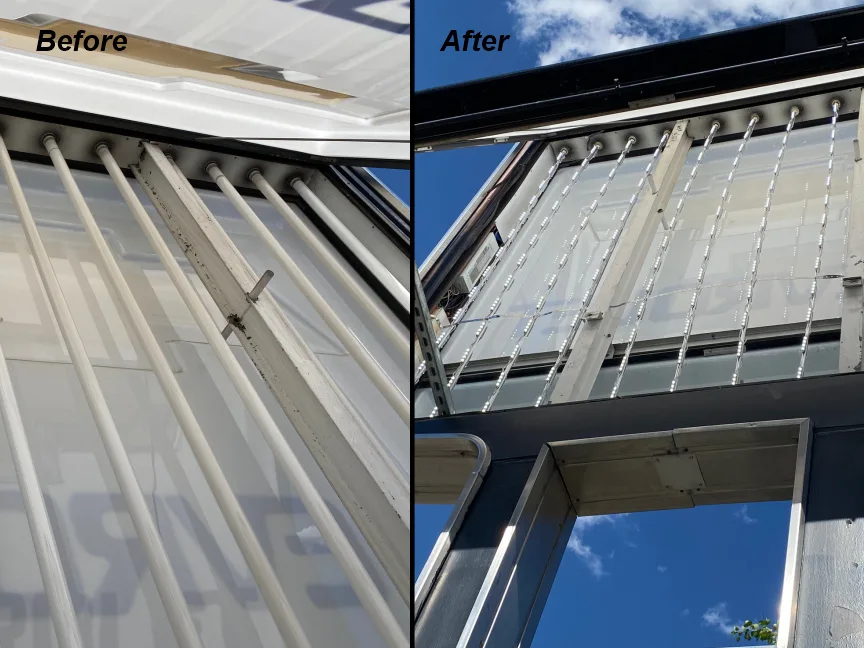
Trang bị thêm đèn LED cũng có thể bao gồm việc thêm các tính năng mới hoặc nâng cấp bảng hiệu tủ để đáp ứng các tiêu chuẩn hoặc quy định hiện hành. Nhìn chung, một bảng hiệu LED Retrofit có thể cải thiện hiệu quả, tuổi thọ và tính bền vững của biển báo của bạn đồng thời giảm thiểu chi phí và tác động đến môi trường.
Trang bị thêm LED: Cần xem xét những gì
Có nhiều lý do để xem xét trang bị thêm đèn LED cho bảng hiệu tủ của bạn. Ngoài ra, không phải bảng hiệu tủ hay loại biển quảng cáo nào khác cũng cần có đèn LED trang bị thêm. Do đó, đây là một số câu hỏi bạn có thể xem xét để xác định xem biển báo của bạn có cần trang bị thêm đèn LED không:
- Bạn có muốn giảm chi phí năng lượng của việc thắp sáng các bảng hiệu tủ của mình không?
- Công nghệ chiếu sáng của bảng hiệu của bạn bao nhiêu tuổi?
- Bạn có đang chi nhiều tiền hơn cho việc bảo trì hệ thống chiếu sáng hiện có của bảng hiệu tủ của mình hơn bạn dự đoán ban đầu không?
- Mức tiêu thụ năng lượng chiếu sáng hàng ngày của bạn là bao nhiêu?
- “Bền vững” và “Môi trường” có phải là ưu tiên hàng đầu cho doanh nghiệp của bạn không?
- Biển báo của bạn bao nhiêu tuổi?
- Bạn có muốn kiểm soát tốt hơn hệ thống chiếu sáng của mình không?
- Bạn có nhận được bất kỳ ưu đãi tài chính nào từ chính phủ hoặc chính quyền địa phương không?
Chuyển đổi đèn huỳnh quang sang ống biển LED
Chuyển đổi đèn huỳnh quang sang bảng hiệu tủ LED sẽ giúp bạn tiết kiệm được rất nhiều tiền. Điện có thể là điều đầu tiên bạn nghĩ đến, nhưng sửa chữa và bảo trì là một khoản chi phí lớn hơn nhiều. Đèn huỳnh quang có tuổi thọ khoảng 10.000 giờ, nghe có vẻ lâu dài, nhưng chạy 10 giờ mỗi ngày sẽ cần thay thế trong vòng chưa đầy 3 năm. Chấn lưu và các hư hỏng khác cũng có thể xảy ra, điều này cũng đòi hỏi nhiều sửa chữa. Những sửa chữa này có thể tốn hàng nghìn đô la mỗi lần, sử dụng cần cẩu hoặc máy bay khác. Và để thêm vào vấn đề, việc thay thế một bộ phận này thường dẫn đến việc thay thế một bộ phận khác, có thể tốn kém. Đèn LED không hoàn hảo, nhưng chúng có thể làm giảm đáng kể việc sửa chữa và kéo dài tuổi thọ của biển báo.
Việc chuyển đổi từ đèn huỳnh quang sang đèn LED đã cải thiện đáng kể hiệu quả và tính bền vững của tủ bảng hiệu LED. của chúng tôi 360 ống đèn LED Cung cấp nhiều lợi ích và là giải pháp trang bị thêm đèn LED trang bị thêm cho đèn huỳnh quang T12HO và T8HO.
Ống biển LED cung cấp nhiều lợi ích, bao gồm:
Tiết kiệm năng lượng nhiều: Đèn LED hiệu quả hơn nhiều, và với thiết kế bỏ qua chấn lưu, bạn có thể thay thế ống huỳnh quang 580W bằng ống ký hiệu 280W cho hộp chiếu sáng 5’x10, tiết kiệm năng lượng 60%.
Cài đặt dễ dàng: Chúng tôi đặt một trình điều khiển bên trong bóng đèn LED này; không cần trình điều khiển bên ngoài. Đối với cài đặt dấu hiệu mới, hãy lắp nó vào và bật nó lên; thế là xong. Đối với trang bị thêm, vẫn sử dụng ổ cắm R17D hiện có; chỉ cần tháo chấn lưu và kết nối trực tiếp với mạch AC.
Góc chùm 360°: Không giống như các giải pháp LED khác, đèn LED Retrofit Tube này được thiết kế đặc biệt cho các biển hiệu tủ. Việc sử dụng ống kính quang học giúp nó bao phủ các khu vực chiếu sáng rộng hơn và loại bỏ các điểm nóng, giúp hiển thị quảng cáo tốt hơn cho khách hàng.
kéo dài hơn: Dựa trên tiêu chuẩn cao, ống LED Retrofit này được chế tạo để kéo dài 50000 giờ, hoặc khoảng 5 lần so với ống huỳnh quang. Được đánh giá theo tiêu chuẩn UL 48 và UL 879A, được bảo hành 5 năm.
Đèn LED Retrofit có kích thước phù hợp với đèn huỳnh quang
Vì ống huỳnh quang thường được lắp vào các biển báo tủ hoặc cột và được kết nối trực tiếp với nguồn điện, và nhiều bảng hiệu tủ hoặc tháp thường rất cao, chúng tương đối đắt tiền và khó thay thế hoàn toàn. Do đó, thường tiết kiệm nhất là thay thế ống huỳnh quang bằng ống LED có cùng kích thước.
Vì lý do này, điều quan trọng là phải biết các loại và kích thước của ống huỳnh quang đã được phát triển để có thể trang bị chính xác ống LED ở vị trí thích hợp.
Trong những năm qua, các nhà sản xuất ống huỳnh quang đã phát triển một loạt các kích cỡ và loại.
- Thiết bị huỳnh quang T8HO: Thiết bị huỳnh quang T8 4 chân và 8 foot cho đến nay là loại phổ biến nhất được sử dụng để chiếu sáng tủ. Chúng có sẵn với chiều dài 48 inch và 96 inch, với đường kính đèn 1 inch.
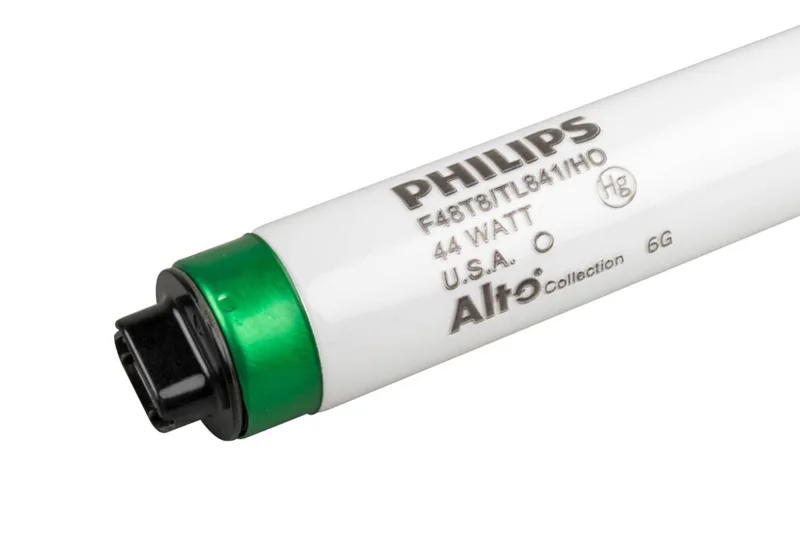
- 【Đèn huỳnh quang T12HO: Đèn huỳnh quang T12 kém hiệu quả hơn đèn T8. Chúng có cùng chiều dài với đèn T8 nhưng có đường kính đèn lớn hơn 1,5 inch.

Các ống huỳnh quang T8HO và T12HO cũng có sẵn ở các độ dài khác, chẳng hạn như ống 8 foot (F96T12DHO), nhưng chiều dài 4 foot vẫn là loại phổ biến nhất. Ống LED trang bị thêm 4 chân. Các thiết bị cố định T8 và T12 thường có cùng chiều dài và sử dụng các chốt giống nhau, vì vậy về mặt cơ học, chúng thường tương thích chéo.
Chấn lưu cho đèn huỳnh quang và trang bị thêm đèn LED
Tất cả các ống huỳnh quang sử dụng một thiết bị gọi là balát để điều chỉnh độ sáng của đèn khi nó được làm ấm, và các thiết bị này cần thiết cho đèn huỳnh quang.
Các thiết bị đèn huỳnh quang thường có chấn lưu được gắn bên trong biển báo, và không thể tiếp cận chấn lưu mà không mở bảng chỉ dẫn. Chỉ những người quen thuộc với công việc điện mới nên trang bị chấn lưu huỳnh quang.
UL Loại A: Tương thích chấn lưu
Thường được gọi là thiết kế “UL Type A”, những đèn LED này được thiết kế để tương thích với chấn lưu huỳnh quang. Chúng là cách dễ dàng nhất để thực hiện, vì chúng không yêu cầu tua lại các thiết bị huỳnh quang. Ống LED loại A UL về cơ bản giống như đèn huỳnh quang và rất đơn giản để thay thế.
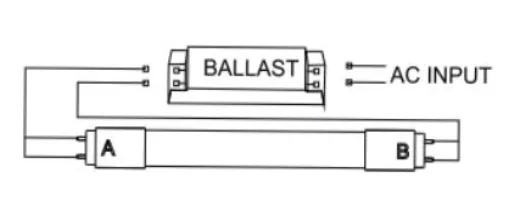
lý tưởng cho: Người tiêu dùng không thoải mái hoặc không muốn tránh làm việc với dây điện và đèn chiếu sáng với chi phí nhân công thợ điện cao.
có hại: Chấn lưu huỳnh quang có thể bị lỗi, đòi hỏi phải bảo dưỡng liên tục và thay thế hoặc bỏ qua chấn lưu; các vấn đề tiềm ẩn với khả năng tương thích của chấn lưu huỳnh quang; hiệu suất điện tổng thể thấp hơn do chấn lưu.
UL loại B: Bỏ qua dằn
Ống LED có thông số kỹ thuật “UL Type B” không tương thích với chấn lưu huỳnh quang. Chúng không thể được sử dụng với chấn lưu huỳnh quang và phải được kết nối trực tiếp với nguồn điện. Tuy nhiên, trình điều khiển LED được tích hợp vào chính ống LED. Ống LED loại B UL có thể được phân loại thêm là một đầu hoặc hai đầu.
Trong cấu hình một đầu, chỉ sử dụng hai chân ở một đầu của đèn (một chân = lửa; một chân = 0), trong khi hai chân ở đầu kia không có chức năng điện và chỉ được sử dụng để giữ đèn tại chỗ. Đối với các cấu hình một đầu, hướng mà đèn được gắn là quan trọng; cấu hình không chính xác có thể dẫn đến việc đèn không sáng lên, hoặc có nguy cơ cháy. Cấu hình một đầu thường có nhãn ở một đầu của đèn có ghi “đầu vào AC” hoặc tương tự.

Trong cấu hình hai đầu, cả hai chân ở cả hai bên của đèn đều có cùng cực. Do đó, giá đỡ đèn ở một đầu đèn phải được kết nối với [ trung tính] và đầu kia phải được kết nối với [trực tiếp].
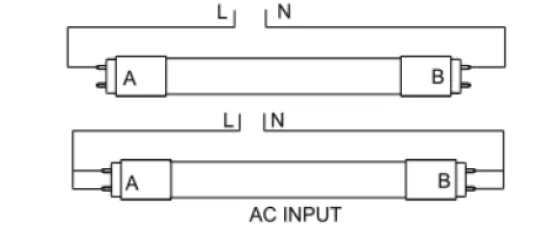
lý tưởng cho: Cài đặt trong đó rewire là một tùy chọn; hiệu quả cao hơn và chi phí bảo trì thấp hơn.
nhược điểm: Yêu cầu sự quen thuộc và hiểu biết về hệ thống dây điện cố định và an toàn điện.
UL loại C: Trình điều khiển từ xa
Ống LED loại C tương đối hiếm nhưng mang lại sự linh hoạt và hiệu quả tối đa cho hệ thống chiếu sáng. Không giống như các ống LED loại B, các ống này không có trình điều khiển LED tích hợp, do đó, một thiết bị dẫn động LED riêng biệt cần được kết nối giữa ống LED và nguồn điện.
tư tưởng: Chi phí bảo trì tối thiểu vì trình điều khiển LED có thể được thay thế mà không cần thay thế toàn bộ ống LED; nhiều tùy chọn trình điều khiển LED hơn như làm mờ 0-10V và kết nối IoT khác.
có hại: Yêu cầu công việc điện nhất là các chấn lưu huỳnh quang cần phải được tháo ra và thay thế bằng các trình điều khiển LED.
Ổ cắm bị tắt so với không bị tắt
Ổ cắm là giá đỡ đèn, nơi gắn ống LED để cung cấp hỗ trợ cơ học và dòng điện. Ổ cắm có hai tiếp điểm điện khớp với hai chân trên ống huỳnh quang / đèn LED. Hai tiếp điểm điện có thể là:
1. Không kết nối với bất kỳ nguồn điện nào
2. một được kết nối với dây lửa và một nối với dây không
3. cả hai được kết nối với đường lửa hoặc đường 0
Kịch bản 2 được gọi là không shunt, trong khi kịch bản 3 được gọi là shunt. “Shunt” là sự kết hợp của hai mạch riêng biệt thành một. Kết quả của một shunt là cả hai tiếp điểm ổ cắm được kết nối với cùng một cực.
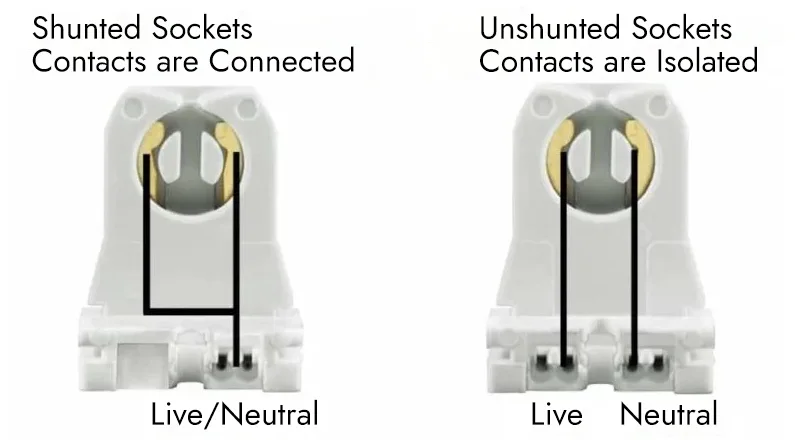
Nói chung, các thiết bị huỳnh quang chưa bao giờ được sửa đổi cho đèn LED hoặc chấn lưu khởi động tức thì có ổ cắm không bị tắt, trong khi các thiết bị huỳnh quang đã được sửa đổi cho đèn LED hoặc chấn lưu khởi động tức thì có thể có ổ cắm bị tắt.
Đôi khi ổ cắm được ngắt bên ngoài, như hình trên, nơi đầu vào dây chỉ được mở ở một bên. Tuy nhiên, trong một số trường hợp, ổ cắm có thể được ngắt bên trong, nơi các đầu vào dây ở cả hai bên đều mở nhưng được kết nối bên trong ổ cắm.
Vì một số ổ cắm được ngắt trong nội bộ, nên việc kiểm tra trực quan ổ cắm sẽ không cung cấp kết quả chính xác. Chúng tôi thực sự khuyên bạn nên kiểm tra cả hai tiếp điểm của ổ cắm với vôn kế để xác định xem có tồn tại mạch kín hay mạch hở hay không. Một mạch kín sẽ chỉ ra một ổ cắm có liên quan.
Cách chuyển đổi bảng hiệu tủ huỳnh quang sang ống LED
Chuyển đổi bảng hiệu tủ huỳnh quang sang ống LED là một quy trình trang bị thêm rất đơn giản nên tuân theo các tiêu chuẩn và mã điện địa phương.
Bước một: Tắt nguồn chính vào mạch nhánh của biển báo hoặc dấu hiệu. Trong trường hợp không có công tắc ngắt kết nối, một công tắc phải được thêm vào để đáp ứng mã. Đảm bảo nối đất thích hợp được liên kết với vỏ biển báo.
Chú ý: Không nên có điện cho người giữ đèn vì bất kỳ lý do gì trong quá trình lắp đặt!
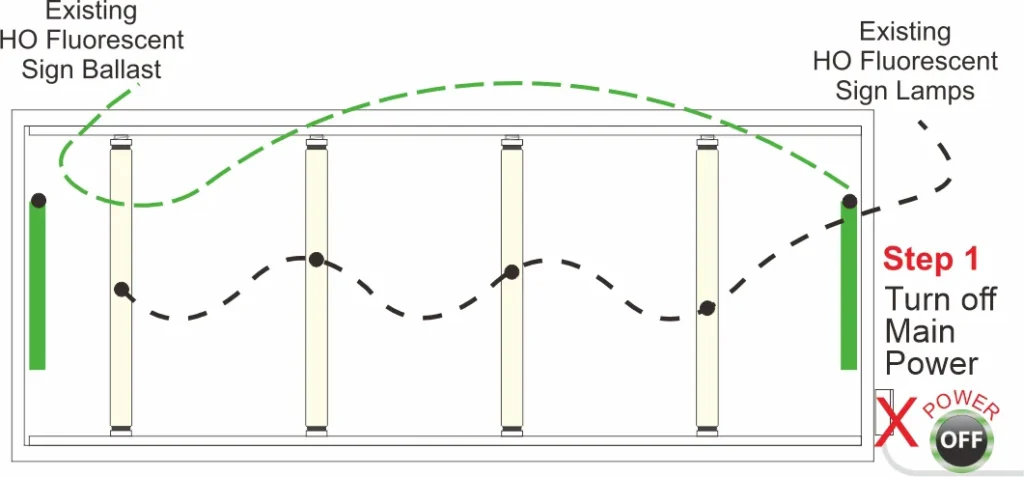
Bước hai: Tháo tất cả đèn HO và chấn lưu và vứt bỏ chúng theo quy định của địa phương. Không ngắt kết nối dây điện hiện có khỏi các đầu cuối của đèn vì bạn sẽ cần chúng một lần nữa trong bước bốn.
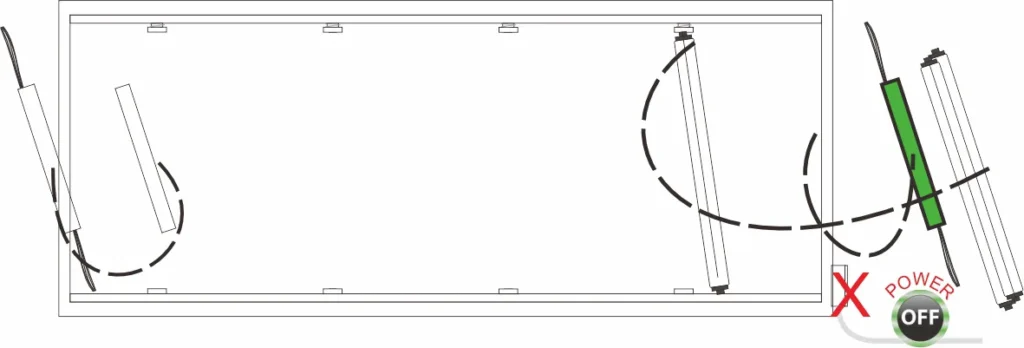
Bước ba: Lắp từng ống đèn LED vào các giá đỡ đèn bằng cách chèn một đầu vào “đèn lò xo” sau đó nén lò xo đủ để xoay đèn về phía đối diện và vào giá đỡ đèn cố định.
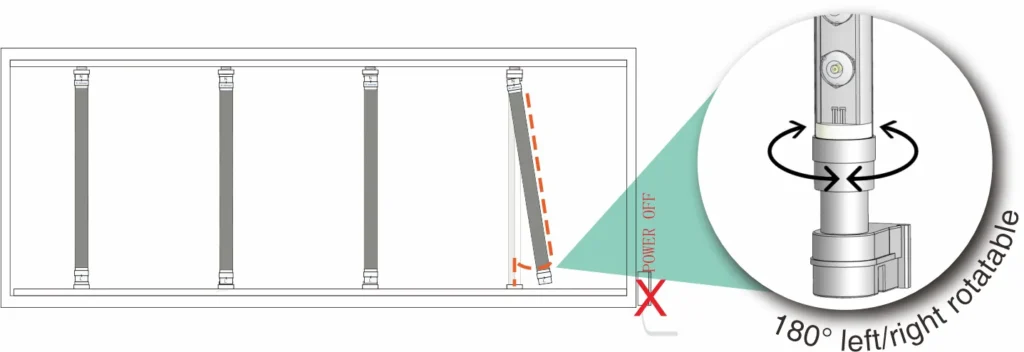
Bước bốn: nối lại các đèn HOF. Đảm bảo tất cả các đèn được định hướng một cách nhất quán, sao cho tất cả các mặt của đèn được đánh dấu “Line (L)” được kết nối với các giá đỡ ở cùng một phía của hộp biển báo và các mặt “N trung tính (N)” được kết nối ở phía đối diện.

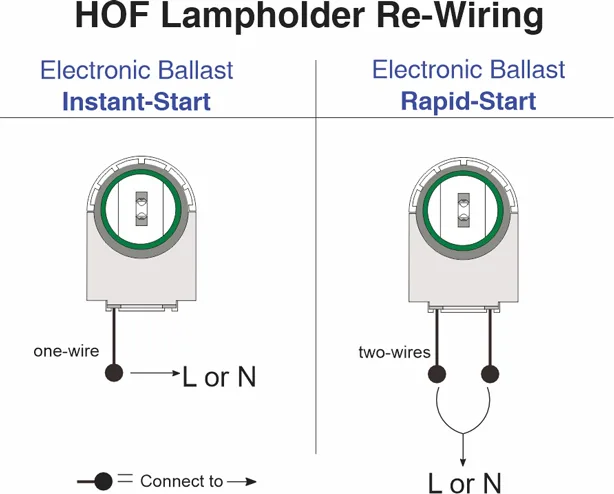
Bước năm: Dán nhãn dán an toàn màu vàng, được cung cấp trong gói, nơi có thể nhìn thấy trực tiếp (tức là gần công tắc hoặc trên đường ray).
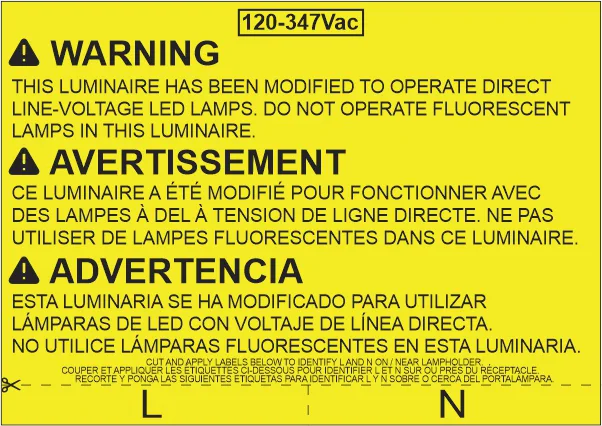
Sơ đồ đấu dây nối song song(để trang bị thêm các biển báo với chấn lưu khởi động tức thì)

Sơ đồ đấu dây nối tiếp (để trang bị thêm các dấu hiệu với chấn lưu khởi động nhanh)

Phần kết luận
Trang bị thêm bảng hiệu LED mang lại nhiều lợi ích cho các doanh nghiệp muốn nâng cao bảng hiệu của họ. Bằng cách nâng cấp lên công nghệ LED, các doanh nghiệp có thể tận hưởng khả năng hiển thị tăng lên, hiệu quả năng lượng cao hơn và chi phí thấp hơn. Biển báo LED cung cấp màn hình sáng hơn, sống động hơn, đảm bảo tầm nhìn tốt hơn vào ban ngày và ban đêm.
Tóm lại, nếu bạn đang cân nhắc chuyển đổi bảng hiệu hiện có của mình sang đèn LED tiết kiệm năng lượng hoặc nếu bạn đang nghĩ đến việc mua một tủ biển báo LED mới, quyết định rất đơn giản. Giá không đắt hơn nhiều so với việc chuyển đổi biển báo của bạn bằng bóng đèn và chấn lưu HO T12. Chi phí bổ sung tương đối nhỏ được vượt qua bởi khoản tiết kiệm khổng lồ mà bảng hiệu sẽ trải qua trong vòng 5 đến 10 năm hoạt động tới. Vì vậy, nếu bạn do dự khi thực hiện chuyển đổi hoặc nếu bạn chỉ cần một báo giá chuyên nghiệp hoàn chỉnh để chuyển đổi bảng hiệu được chiếu sáng của bạn sang đèn LED, Signlited có thể giúp bạn và tổ chức của bạn.
Signiteled là một đèn chiếu sáng tuyến tính LED của Trung Quốc và Đèn LED bảng hiệu công ty chuyên LED灯带 và nguồn sáng biển báo LED. Tất cả các sản phẩm của chúng tôi được kiểm tra và thiết kế cho thời tiết khắc nghiệt và tuổi thọ. Liên hệ với chúng tôi ngay hôm nay để được tư vấn miễn phí.
